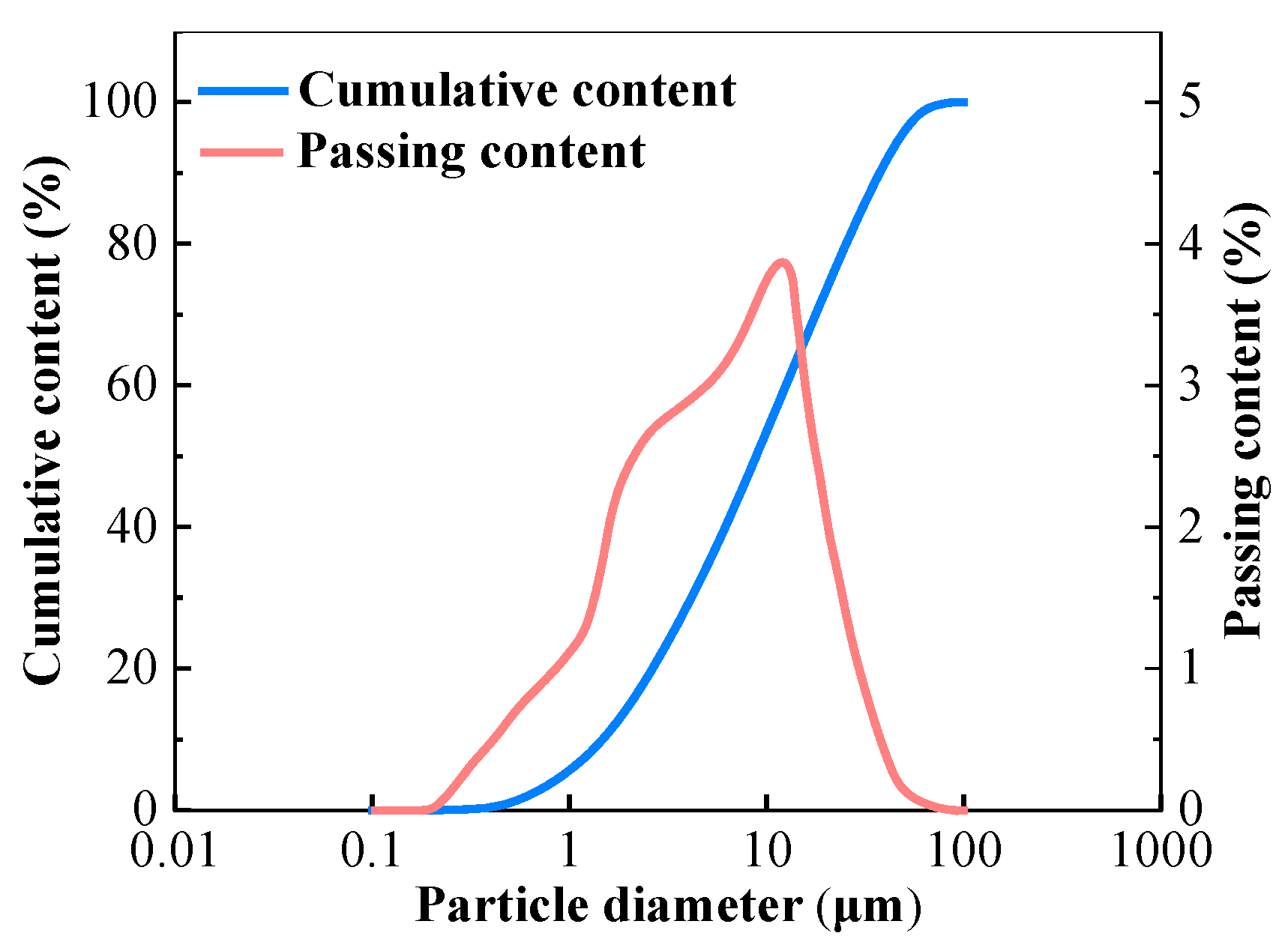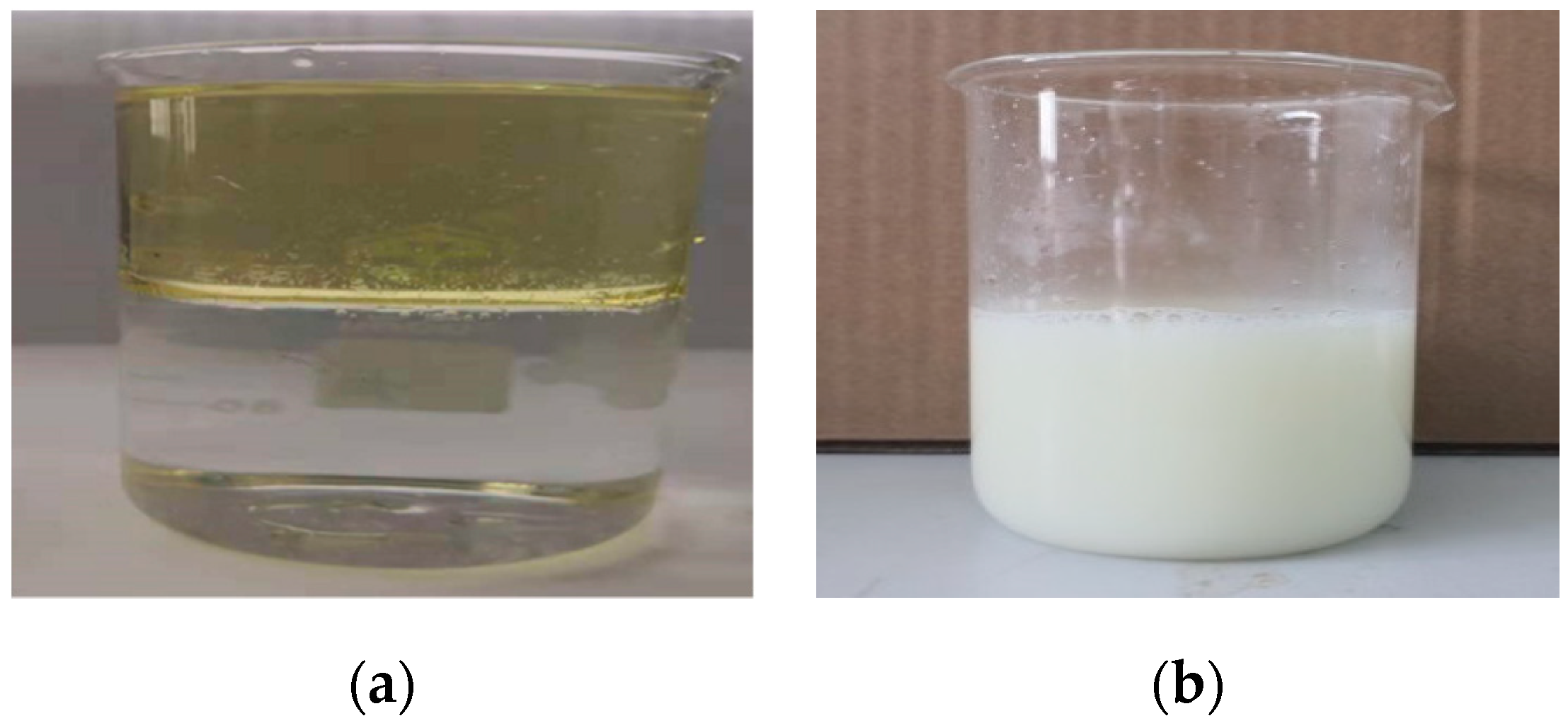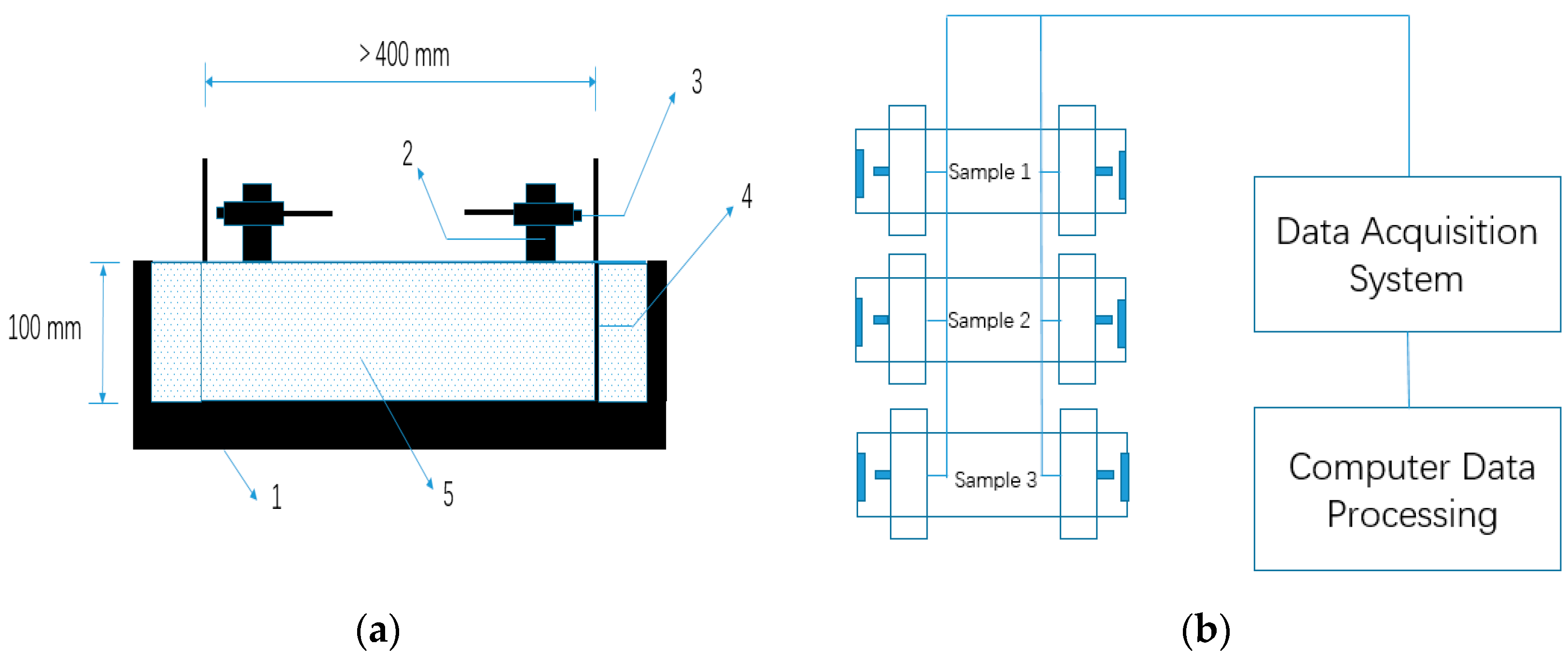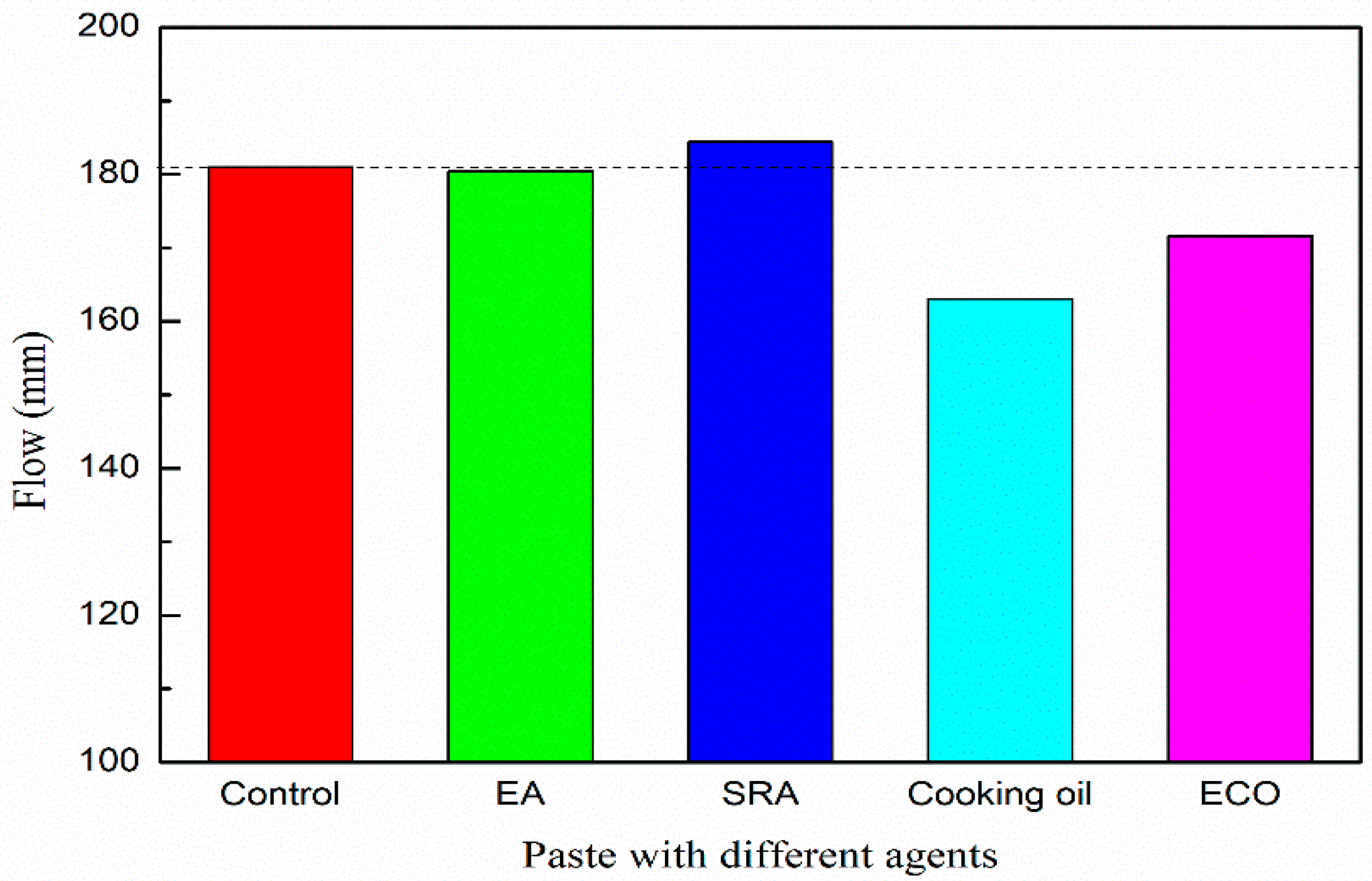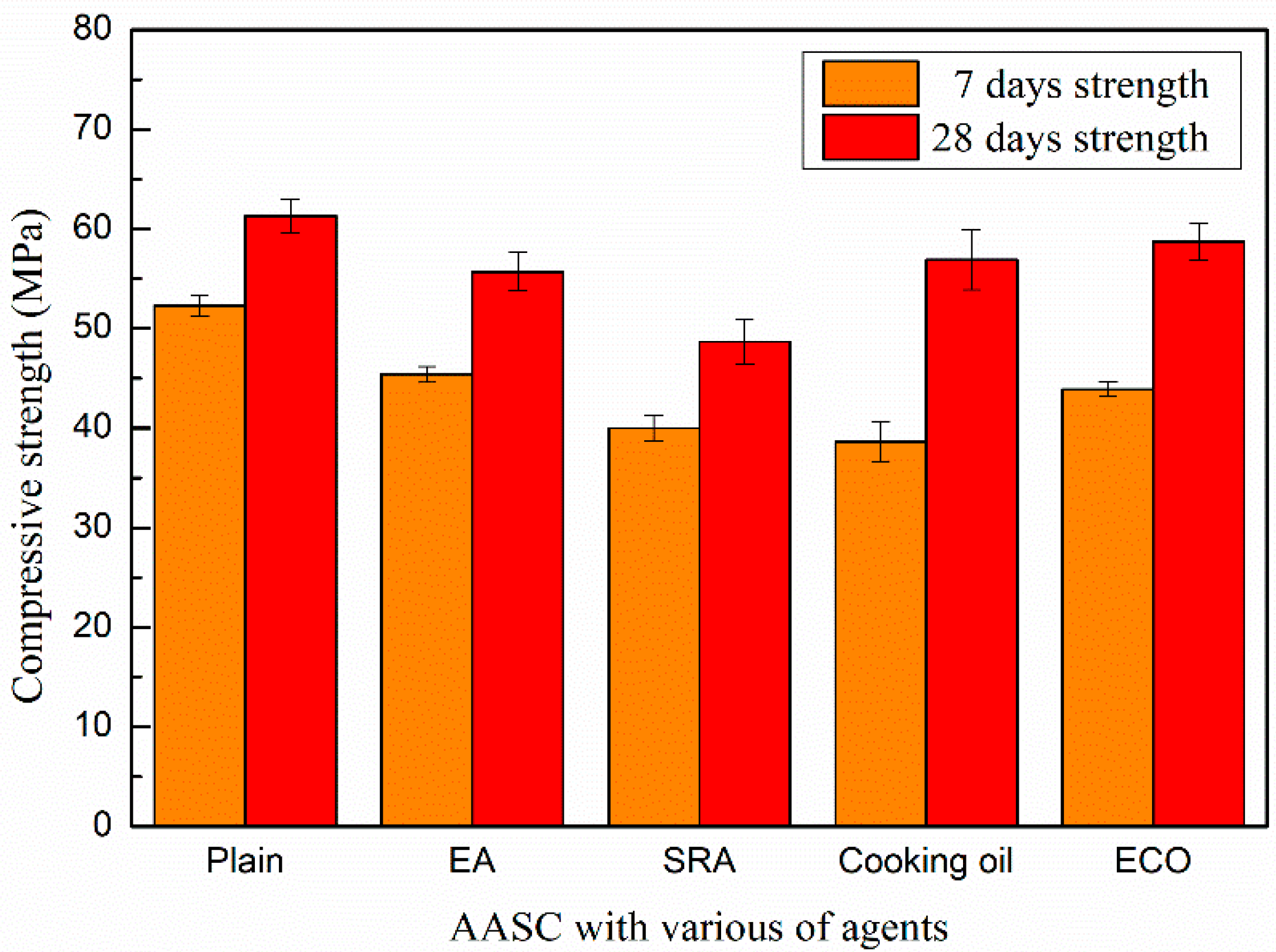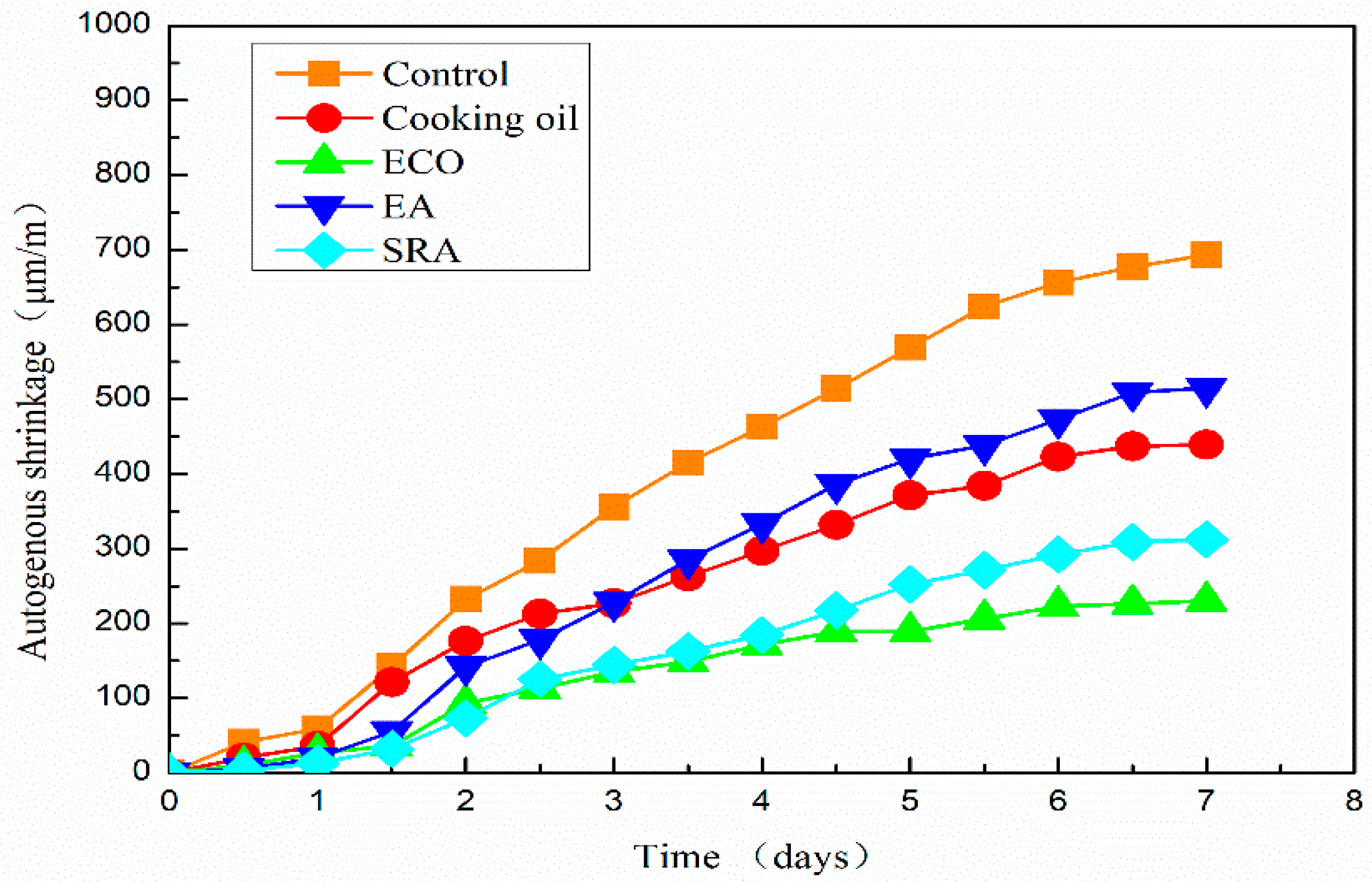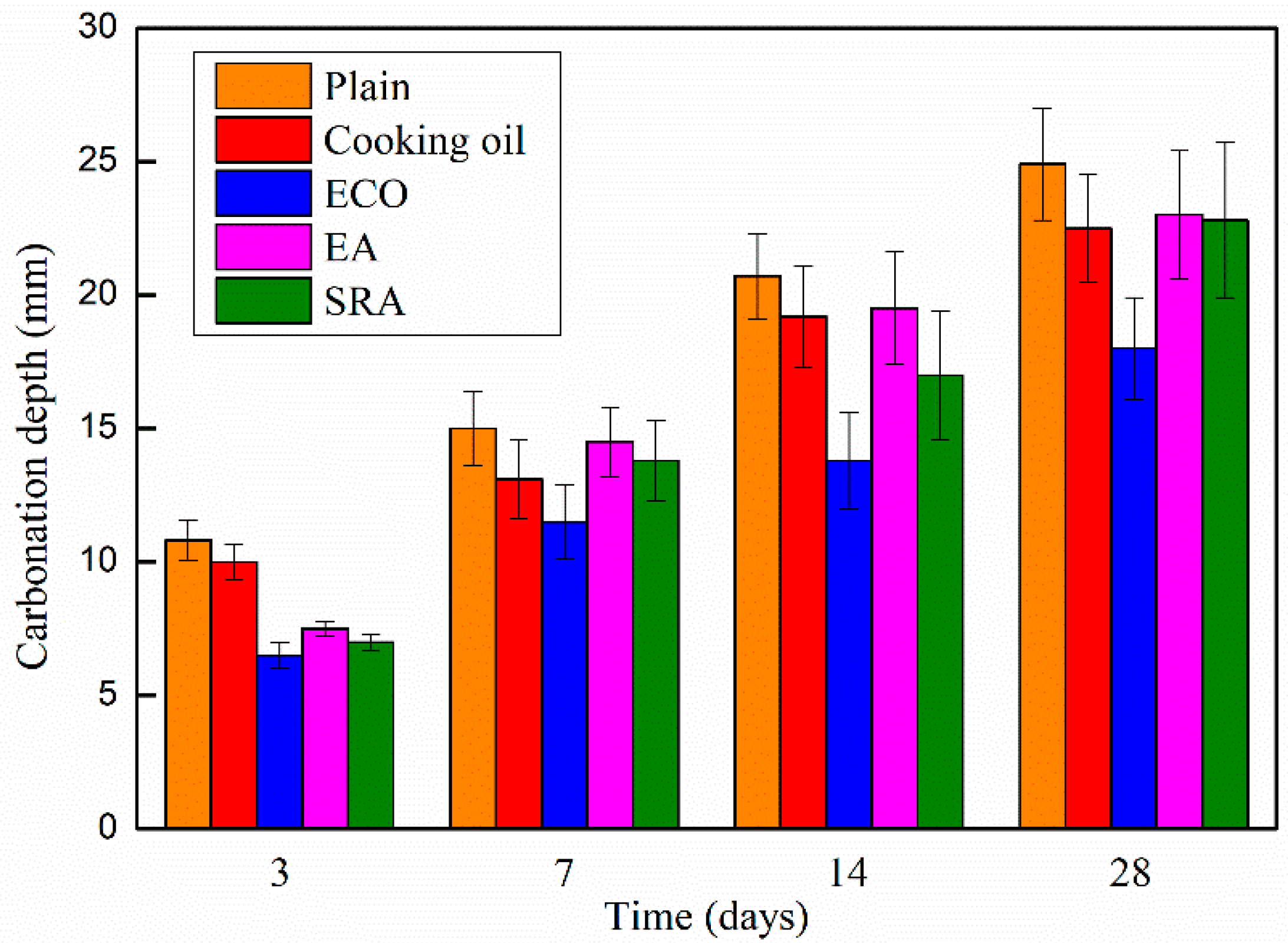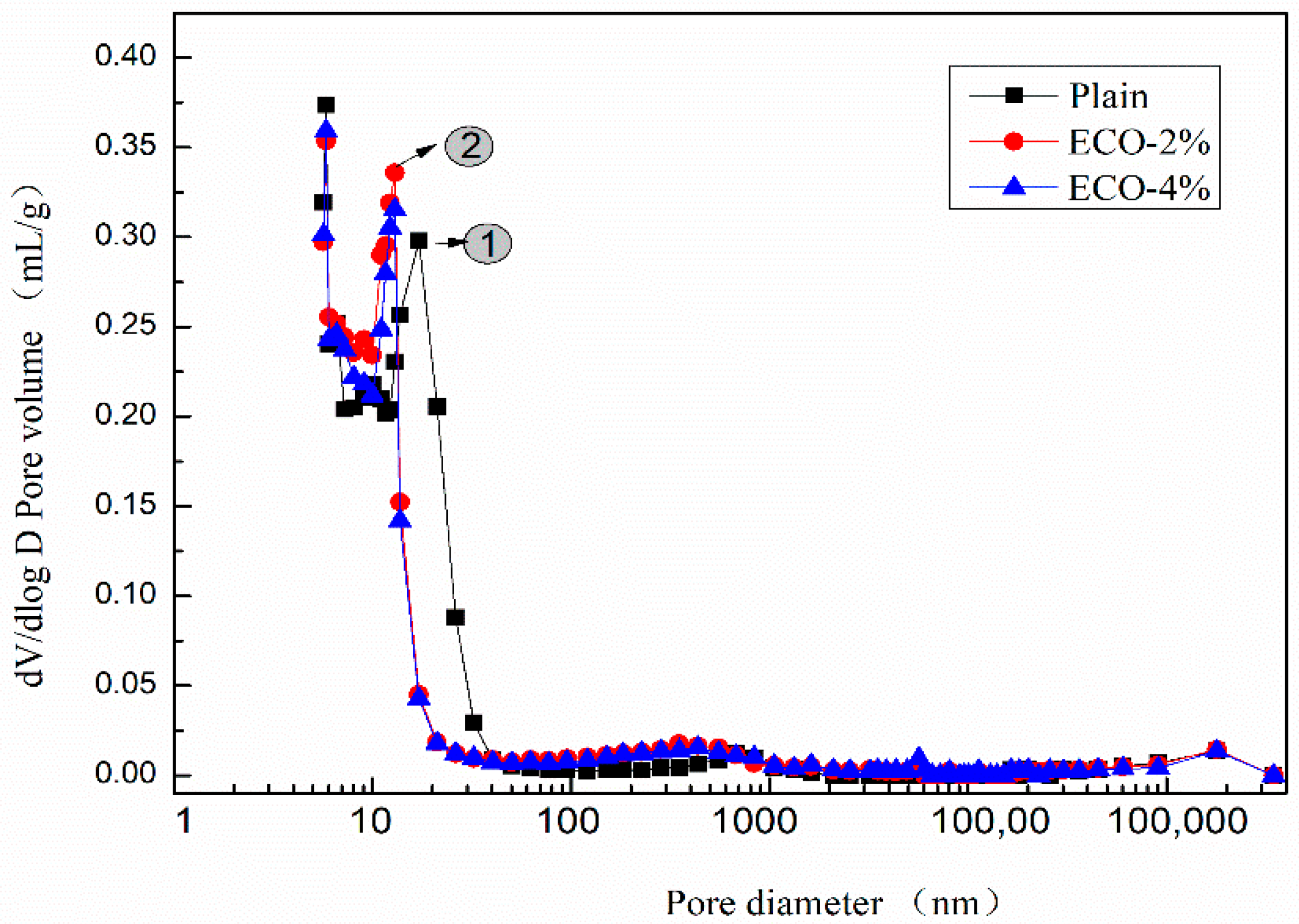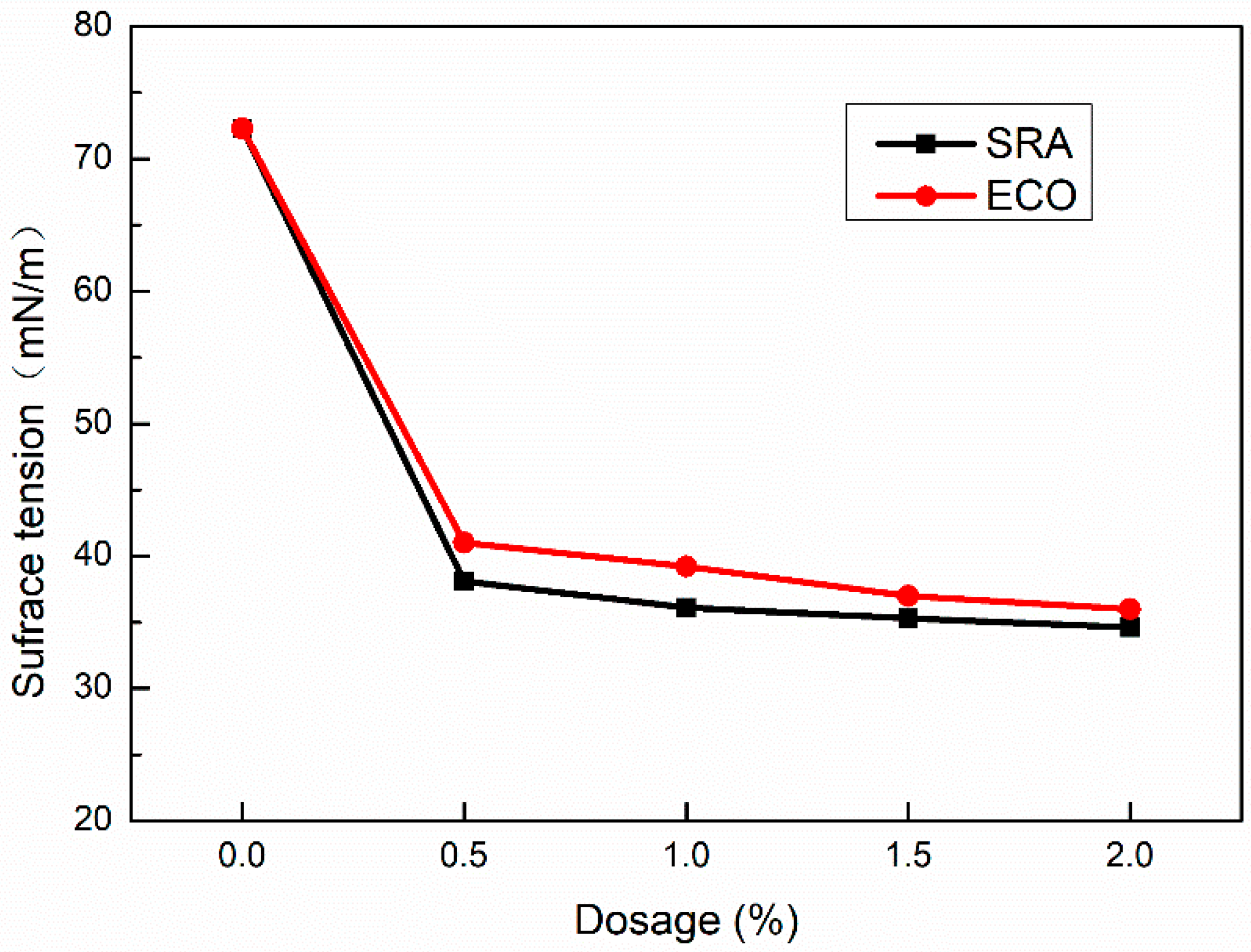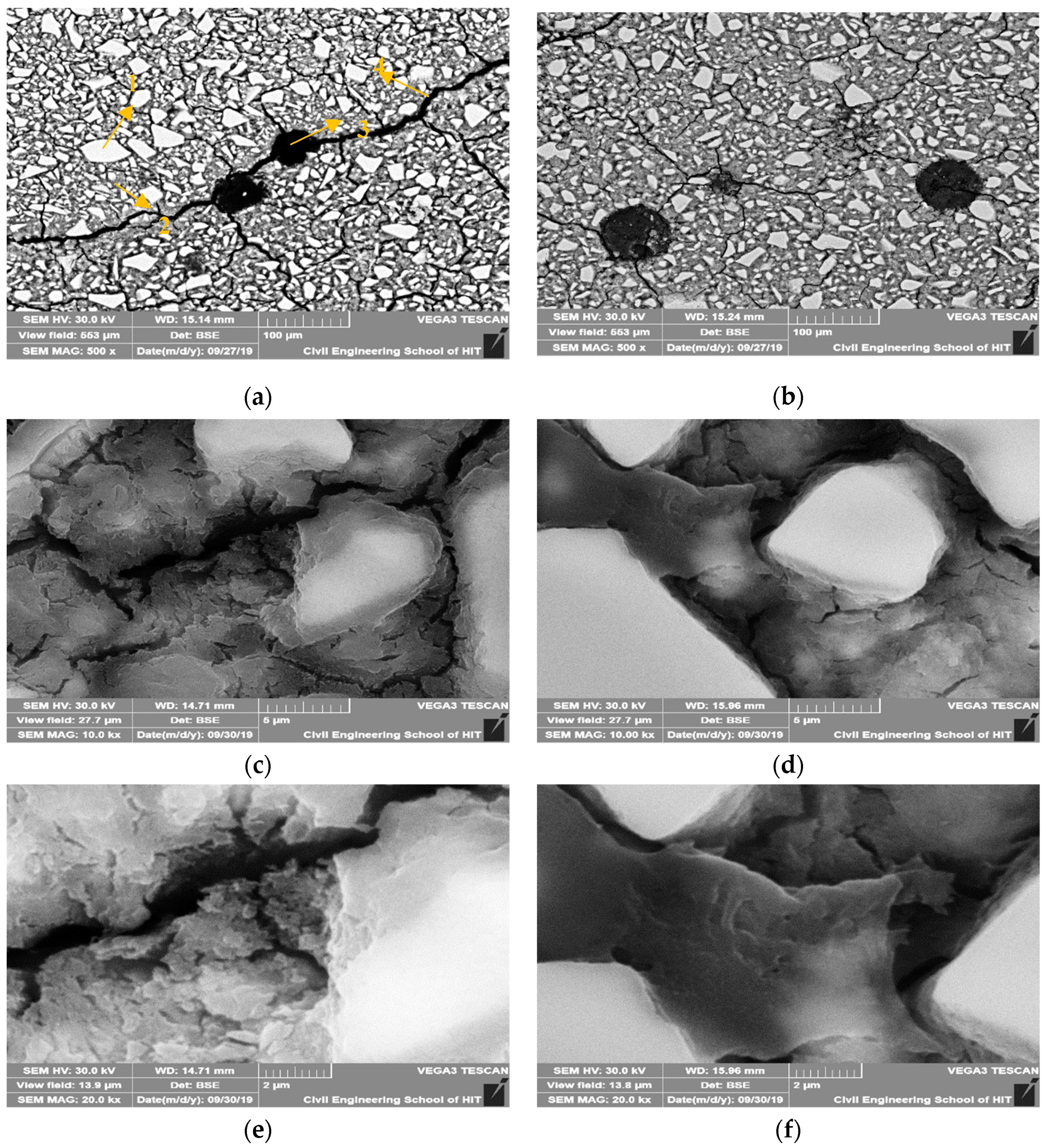1. Introduction
Production of ordinary Portland cement is currently a serious source of global warming. Roughly 0.7–1 ton of CO
2 is released while producing 1 ton of cement [
1]. About 7% of global CO
2 emissions is contributed by cement manufacture-related activities, and the production of cement is considered as the third largest producer of greenhouse gas [
2,
3].
Therefore, numerous studies have been focusing on eco-friendly alternative supplementary cementitious materials to limit the emission of CO
2. Ground granulated blast furnace slag (GGBFS) is a type of industrial by-product obtained during pig-iron manufacturing and is generally used as supplementary cementitious materials [
4]. Compared with ordinary Portland cement (OPC)-based binder, the application of GGBFS can remarkably decrease hydration heat and increase the durability of concrete [
5]. However, the relatively low early age strength of GGBFS limits its applications [
6]. Since the 1940s, researchers have found that alkali activation could overcome the shortage of low early age strength of GGBFS-contained binders [
7,
8]. A series of investigations into alkali-activated slag binder have been carried out in the past two decades [
9,
10,
11,
12,
13]. The utilization of alkali-activated slag binder or alkali-activated slag concrete (AASC) can provide superior performances including superior mechanical performance, higher resistance to chemical attack, frost-thaw performance, lower heat of hydration, lower permeability, and good thermal performance [
14,
15,
16,
17].
Despite environmental and property advantages, one problem limiting the application of AASC is high shrinkage, which is one of the main factors contributing to early age cracking [
18]. Shrinkage in concrete mainly has two forms: Drying shrinkage and autogenous shrinkage. In AASC, which form of shrinkage being dominant is still controversial [
19]. The shrinkage in AASC is reported about 1.7–2 times larger than the OPC-based concrete [
20,
21,
22]. High shrinkage may cause cracks and degrade the durability of AASC. The service life of AASC may be highly shortened due to high shrinkage and the maintenance costs of repairing cracks may also dramatically increase.
To solve the shrinkage problem, many researchers are focused on the utilization of admixtures to mitigate the shrinkage of AASC. Expansive agents (EA) and shrinkage reducing agents (SRA) are two types of widely used admixtures to inhibit concrete shrinkage [
22,
23,
24]. However, most of the EA and SRA are based on OPC concrete and not all admixtures work effectively in AASC. For instance, gypsum is one type of commonly used EA in OPC-based concrete, but the application of gypsum in AASC is reported insufficient to compensate for long age shrinkage [
22]. Moreover, the adding amount of EA is difficult to quantify and several negative side effects on the properties of AASC may also be generated [
22,
24,
25]. Other research have focused on using lightweight aggregates and super absorbent polymers as internal curing materials in AASC or using an elevate temperature curing method to mitigate shrinkage [
26]. These approaches have had a good effect on the mitigation of shrinkage in AASC. However, these methods are considered high cost approaches in a practical application point of view and some of these approaches are also considered less suitable to use in-situ. Therefore, a new strategy to mitigate the shrinkage of AASC with high added value and applicability to in-situ is still needed.
Cooking oil is a type of necessity which could be easily obtained around the world. Recently, some studies focused on the application of cooking oil on concrete [
27,
28,
29,
30,
31,
32,
33]. It has been reported that after being pretreated by cooking oil, recycled aggregate has shown better performance in asphalt concrete [
32]. The utilization of linseed oil could enhance the durability of lime-based mortar [
29]. A few studies have also used cooking oil as a shrinkage-reducing agent in OPC-based concrete [
27]. Shrinkage of OPC-based concrete is significantly reduced by the utilization of oil-based admixture due to the reaction between CaO and fatty acid [
27]. GGBFS also contains a large quantity of CaO, and the chemical reaction between CaO and fatty acid may also be generated, therefore the addition of cooking oil may theoretically decrease the autogenous shrinkage in AASC. In addition, some researchers have found that shrinkage could be reduced significantly by decreasing the surface tension of the pore solution in concrete [
34]. As known, the surface tension of the solution highly depends on its density and cooking oil has a lower density than water. Thus, the surface tension of the water/oil solution after emulsification is lower than pure water, and the lower surface tension by applying cooking oil in AASC is possibly another factor that is predicted to decrease the shrinkage of AASC. In comparison to OPC-based concrete, the autogenous shrinkage problem of AASC is even more serious, and as known, no studies have focused on this aspect. Therefore, the potential application of cooking oil as a shrinkage reducing agent into AASC is necessary.
The primary aim of this article is to investigate the effects of plain cooking oil and emulsified cooking oil (ECO) on the shrinkage-reducing performance of AASC. Commercially available EA and SRA are also applied to AASC for comparison with cooking oils. First, experiments on paste are carried out to compare the effects of flow and setting time of the alkali-activated slag paste with four different agents. Then, four mixing approaches, each with the same dosage of four kinds of agents, are explored to evaluate the effect of cooking oil on the durability and mechanical properties of AASC. Compressive strength, autogenous shrinkage, and carbonation depth are tested. Finally, surface tension experiment, mercury intrusion porosimetry (MIP) and SEM analysis are also carried out to discuss the mechanism of the shrinkage-reducing effect of ECO.
4. Conclusions
In this study, ECO was applied to AASC as a shrinkage-reducing agent and compared with SRA, EA, and cooking oil. The results indicated that cooking oil after emulsification could significantly reduce the autogenous shrinkage of AASC. The following conclusions could be drawn:
The addition of cooking oil and ECO slightly decreased the flowability of concrete due to the increase of the viscosity. However, the influence of ECO on the flowability of concrete was weaker than that of cooking oil without emulsification. The utilization of SRA showed the best flowability in all the four types of agents;
With the exception of using EA, setting times of concrete were prolonged with the addition of agents used. Particularly, the addition of ECO could sharply retard the initial setting time of AASC due to a covering insolubility film on the GGBFS particles which may delay hydration. Through the application of ECO, AASC showed an acceptable setting time which is considered to benefit the application of AASC in-situ;
Compressive strength was substantially reduced at an early age with the addition of agents. However, the ECO would deliver higher compressive strength among the four agents. The decreased early age strength caused by ECO and cooking oil was attributed to the delay of the hydration. With age developed, the negative influence of ECO on the compressive strength was weakened. For the 28th day compressive strength, AASCs with and without ECO were almost the same;
All agents could reduce the autogenous shrinkage of AASC. Among them, ECO showed to have a better effect on the reduction of shrinkage. Compared with the plain mixture, the utilization of ECO could reduce 66.8% of autogenous shrinkage on the 7th day due to the decrease of the surface tension and saponification reaction. This indicates that the application of ECO on AASC may provide a solution for the application of high autogenous shrinkage problem of AASC;
The addition of ECO could enhance the carbonation resistance of AASC. The carbonation depth of AASC on the 28th day was reduced 27.7% by the use of ECO. The reduction of carbonation depth was mainly caused by the denser inner structure of AASC;
Porosity and capillary pores volume of AASC decreased with the addition of ECO. Moreover, the surface tension of the AASC decreased with the addition of ECO, which are the origination of the reduction of autogenous shrinkage.
In comparison to SRA and EA, using ECO as a shrinkage-reducing agent showed better durability and mechanical performance. ECO could also deliver a setting retardant effect and higher carbonation resistance, which can be considered beneficial for applying AASC on a construction site.
AASC is a type of eco-friendly material and with a superior performance over OPC-based concrete in many aspects. The high shrinkage, rapid setting, and high carbonation depth of the AASC are considered the three main drawbacks that limit the application of AASC. In view of the results conducted by this paper, utilizing ECO may provide a solution for these drawbacks, and become beneficial to the wider application of AASC. Moreover, in comparison with other agents, cooking oil-based ECO is widely available around the world. Utilizing ECO is considered a cheap and easy way to overcome the limitations of AASC.
